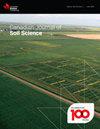Tillage and Nitrogen Rate Effects on Winter Wheat Yield in a Wheat-Sorghum Rotation
IF 1.5
4区 农林科学
Q4 SOIL SCIENCE
引用次数: 0
Abstract
The objectives of this study were to quantify long-term tillage practice and nitrogen (N) fertilizer rate effects on yield and N use in a winter wheat (Triticum aestivum L) -grain sorghum (Sorghum bicolor L. Moench) -fallow (W-S-F) rotation. The experimental design was a randomized complete block with split-split-plot arrangement. The main plot treatments were crop rotation phases, W-S-F, S-F-W, and F-W-S. The sub-plots were tillage practices, i.e., conventional tillage (CT), reduced tillage (RT), and no-tillage (NT). And the sub-sub-plot treatments were N rates 0, 45, 90, and 134 kg ha-1. Wheat yield increased at rates of 15.6, 9.3, 22.8, and 25.7 kg ha-1 for a kg N ha-1 increase in very low, low, high, and very high yielding environments (average yields of ~2000, 2500, 2800, and 4400 kg ha-1), respectively. On average, winter wheat yields were 7-9% greater for CT compared with both NT and RT. Winter wheat removed about 52 kg N ha-1 from the unfertilized control treatment but N uptake varied by N rate and growing conditions. Nitrogen use efficiency, N agronomic efficiency, and applied N recovery decreased as N rate increased. Across environments, wheat yield increased by 16, 20, and 17 kg ha-1 for each additional kg ha-1 N applied under CT, NT and RT, respectively, and additional 2-2.5 kg ha-1 yield increases for a mm increase in fallow precipitation. We concluded that wheat yield response to N is highly dependent on growing condition and NT required greater N fertilization than CT and RT for similar yields.小麦-高粱轮作中耕作方式和施氮量对冬小麦产量的影响
本研究的目的是量化长期耕作实践和氮肥用量对冬小麦(Triticum aestivum L)-高粱(sorghum bicolor L.Moench)-休耕(W-S-F)轮作产量和氮利用的影响。实验设计是一个随机完全区组,采用分裂-分裂图排列。主要小区处理为轮作期、W-S-F、S-F-W和F-W-S。分区为耕作方式,即常规耕作(CT)、减少耕作(RT)和免耕(NT)。亚小区处理分别为0、45、90和134kgha-1。在极低、低、高和极高产量环境中,小麦产量分别以15.6、9.3、22.8和25.7 kg ha-1的速率增加,每增加一kg N ha-1(平均产量分别为约2000、2500、2800和4400 kg ha-1)。与NT和RT相比,CT处理的冬小麦产量平均高出7-9%。冬小麦从未受精的对照处理中去除了约52kg的N ha-1,但N吸收量因N速率和生长条件而异。氮利用效率、氮农艺效率和施氮回收率随施氮量的增加而降低。在不同环境中,在CT、NT和RT条件下,每增加一公斤ha-1 N,小麦产量分别增加16、20和17公斤ha-1,休耕降水量增加一毫米,小麦产量增加2-2.5公斤ha-1。我们得出的结论是,小麦对氮的产量反应高度依赖于生长条件,对于类似的产量,NT需要比CT和RT更多的氮施肥。
本文章由计算机程序翻译,如有差异,请以英文原文为准。
求助全文
约1分钟内获得全文
求助全文
来源期刊

Canadian Journal of Soil Science
农林科学-土壤科学
CiteScore
2.90
自引率
11.80%
发文量
73
审稿时长
6.0 months
期刊介绍:
The Canadian Journal of Soil Science is an international peer-reviewed journal published in cooperation with the Canadian Society of Soil Science. The journal publishes original research on the use, management, structure and development of soils and draws from the disciplines of soil science, agrometeorology, ecology, agricultural engineering, environmental science, hydrology, forestry, geology, geography and climatology. Research is published in a number of topic sections including: agrometeorology; ecology, biological processes and plant interactions; composition and chemical processes; physical processes and interfaces; genesis, landscape processes and relationships; contamination and environmental stewardship; and management for agricultural, forestry and urban uses.
 求助内容:
求助内容: 应助结果提醒方式:
应助结果提醒方式:


